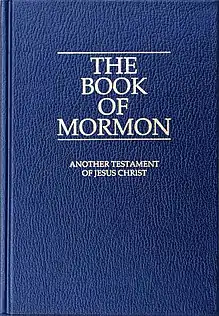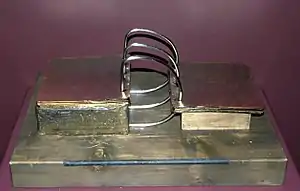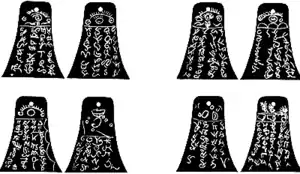| Part of a series on the |
| Book of Mormon |
|---|
 |
Engraved metal plates hold a special significance in the Latter Day Saint movement because in 1827, the founder of that religion, Joseph Smith, claimed to have obtained a set of engraved golden plates from an angel and from them translated into English the Book of Mormon, a religious text of that religious tradition.
Latter Day Saints believe that other engraved metal plates exist, most of which are mentioned in the Book of Mormon. In addition, Mormon apologists argue that the golden plates are part of a long tradition of writing on engraved metal plates in the Middle East.
The golden plates

The golden plates are a set of bound and engraved metal plates that Latter Day Saint denominations believe are the source of Joseph Smith's English translation of the Book of Mormon. Although several witnesses said they saw the plates, Smith said that he returned them to an angel after the translation was completed. Most Latter Day Saints assume their authenticity as a matter of faith.
Smith said he discovered the plates on September 22, 1823, on Cumorah hill, Manchester, New York, where he said they had been hidden in a buried box and protected for centuries by the angel Moroni, a resurrected ancient American prophet-historian, who had been last to write on them. Smith claimed that the angel required him to obey certain commandments prior to receiving them and that his inability to obey prevented him from obtaining the plates until four years later, on September 22, 1827.[1]
During this period, Smith also began dictating written commandments in the voice of God, including a commandment to form a new church and to choose eleven men who would join Smith as witnesses of the plates. These witnesses later declared, in two separate written statements attached to the 1830 published Book of Mormon, that they had seen the plates.[2]
The Book of Mormon is accepted by adherents of the Latter Day Saint movement as a sacred text.
Other plates referred to in the Book of Mormon
In addition to the golden plates, the Book of Mormon refers to several other sets of books written on metal plates:
- The brass plates, originally in the custody of Laban, containing the writings of Old Testament prophets before the Babylonian exile, as well as the otherwise unknown prophets Zenos, Zenoch, Neum, and possibly others.
- The large plates of Nephi, the source of the text abridged by Mormon and engraved on the golden plates.
- The small plates of Nephi, the source of the first and second books of Nephi, and the books of Jacob, Enos, Jarom and Omni, which replaced the lost 116 pages.
- The plates of Limhi
- A set of twenty-four plates found by the people of Limhi containing the record of the Jaredites, translated by King Mosiah, and abridged by Moroni as the Book of Ether.
Kinderhook plates

In 1843, Smith acquired a set of six small bell-shaped plates, known as the Kinderhook Plates, found in Kinderhook, Pike County, Illinois. The plates were manufactured and buried by three men who lived in Kinderhook, and who had intended the plates as a prank against the LDS community. Although Smith did not translate the plates, William Clayton, his secretary, wrote that Smith said they contained "the history of the person with whom they were found and he was a descendant of Ham through the loins of Pharaoh king of Egypt." As Richard Bushman has written, "Joseph may not have detected the fraud, but he did not swing into a full-fledged translation as he had with the Egyptian scrolls. The trap did not quite spring shut, which foiled the conspirators original plan."[3] After Smith's death, the Kinderhook plates were presumed lost, and for decades the Church of Jesus Christ of Latter-day Saints (LDS Church) published facsimiles of them in its official History of the Church. In 1980, the Kinderhook Plates were tested at Brigham Young University and determined to have been manufactured during the nineteenth century. Today, the LDS Church acknowledges that the Kinderhook plates were a hoax.[4][5]
Voree Plates and the Book of the Law of the Lord
James J. Strang, one of many rival claimants to succeed Smith in the 1844 succession crisis, said that he had discovered and translated a set of plates known as the Voree Plates or "Voree Record." Like Smith, Strang produced witnesses to testify to his plates' authenticity.[6] Although Strang's attempt to supplant Brigham Young as Smith's successor proved abortive, Smith's mother, Lucy Mack Smith,[7] and for a time all living witnesses to the Book of Mormon, including the three Whitmers and Martin Harris (although perhaps excluding Oliver Cowdery), accepted "Strang's leadership, angelic call, metal plates, and his translation of these plates as authentic."[8] Strang equally claimed to have discovered and translated the Plates of Laban spoken of in the Book of Mormon. As with the Voree Plates, Strang produced witnesses who authenticated them. Strang's purported translation of these plates was published in 1850 as the Book of the Law of the Lord, which together with the Voree Record, is accepted as Scripture by members of Strang's diminutive church, the Church of Jesus Christ of Latter Day Saints (Strangite).[9]
Metal plates in Mormon studies
William J. Hamblin argues that the golden plates are part of a long tradition of writing on engraved metal plates in the ancient Mediterranean.[10] Some examples of brief hieroglyphic inscriptions on bronze are known from ancient Egypt.[11] Some ancient European and Mesopotamian cultures did keep short records on metal plates, but extant examples are rare, have comparatively brief texts, and are extremely thin. A six-page, 24-carat gold book bound together with rings, alleged to be written in Etruscan, was found in Bulgaria;[12] and in 2005, an eight-page golden codex bound with rings, allegedly from the Achaemenid period, was recovered from smugglers by the Iranian police. The Pyrgi Tablets (now at the National Etruscan Museum, Rome) are gold plates with a bilingual Phoenician-Etruscan text.[13] In the caves where the Dead Sea Scrolls were found, archaeologists later discovered the "Copper Scroll," two rolled sheets of copper that may describe locations where treasures of the Second Temple of Jerusalem may have been hidden.[14] Another Israelite example is the tiny "Silver Scrolls" dated to the 7th century BCE (First Temple period), containing just a few verses of scripture, perhaps the oldest extant passages of the Old Testament.[15] Nevertheless, there is no known extant example of writing on metal plates from the ancient Mediterranean longer than the eight-page Persian codex, and none from any ancient civilization in the Western Hemisphere.[16] However, the Mandaeans of Iran are reported to maintain their entire Book of John in metal book made entirely of lead plates[17]
See also
Notes
- ↑ Bushman, Rough Stone Rolling pp. 58–61, 77–79.
- ↑ Bushman, pp. 77–79.
- ↑ Bushman (2005, p. 490) The original source is William Clayton's Journal, May 1, 1843 (See also, Trials of Discipleship — The Story of William Clayton, a Mormon, 117): "I have seen 6 brass plates ... covered with ancient characters of language containing from 30 to 40 on each side of the plates. Prest J. has translated a portion and says they contain the history of the person with whom they were found and he was a descendant of Ham through the loins of Pharaoh king of Egypt, and that he received his kingdom from the ruler of heaven and earth." The information was deemed important enough to be republished in the first person (as if Smith had said it) in the History of The Church: "I insert facsimiles of the six brass plates found near Kinderhook .... I have translated a portion of them, and find they contain the history of the person with whom they were found. He was a descendant of Ham, through the loins of Pharaoh, king of Egypt, and that he received his kingdom from the Ruler of heaven and earth." More than six pages in Volume Five of History of the Church discuss the Kinderhook plates.
- ↑ Richard Bushman, Joseph Smith: Rough Stone Rolling (New York: Alfred A. Knopf, 2005) pp. 489–90.
- ↑ Stanley B. Kimball, "Kinderhook Plates Brought to Joseph Smith Appear to Be a Nineteenth-Century Hoax", Ensign, August 1981.
- ↑ Strang, James J. "The Record of Rajah Manchou of Vorito." Archived 2012-09-17 at archive.today Church of Jesus Christ of Latter Day Saints. Retrieved on 2008-03-18.
- ↑ In a letter of 11 May 1846 Lucy Mack Smith wrote: "I am satisfied that Joseph appointed J. J. Strang." The same day William Smith said, "James J. Strang has the appointment and we have evidence of it. The whole Smith family excepting Hyrum's widow uphold Strang." Palmer, 211. Earlier Lucy Mack Smith said at the October 1844 General Conference that she hoped all her children would accompany the saints to the West, and if they did she would go.
- ↑ Palmer, 208-13. Cowdery's father converted to Strang's movement in the summer of 1846, and a year later Oliver Cowdery was living in Elkhorn, Wisconsin, 12 miles (19 km) from Strang's headquarters and may have been associated in some way with his church. Stanley R. Gunn, Oliver Cowdery: Second Elder and Scribe (Salt Lake City: Bookcraft, 1962), 189. Lucy Mack Smith's acceptance of Strang's leadership was short-lived; until her death, she made her home in Nauvoo with her daughter-in-law Emma and Emma's non-Mormon husband. (Bushman, 554-55).
- ↑ The Book of the Law of the Lord. Archived 2013-10-21 at Archive-It Church of Jesus Christ of Latter Day Saints. Retrieved on 2008-03-18.
- ↑ William J. Hamblin, "Sacred Writing on Metal Plates in the Ancient Mediterranean," FARMS Review19/1 (2007), 37–54.
- ↑ R. Parkinson, Cracking Codes (U.C. Press, 1999), 108 #30, and color plate 18 (inscribed bronze fitting of King Amenhotep IV), p. 147 # 62 (Roman period bronze plaque inscribed on both sides with neo-Middle Egyptian hieroglyphic text).
- ↑ Unique book goes on display. BBC News, 2003-05-23. Retrieved on 2008-03-18. "'The six sheets are believed to be the oldest comprehensive work involving multiple pages', said Elka Penkova, who heads the museum's archaeological department. 'There are around 30 similar pages known in the world', Ms Penkova said, 'but they are not linked together in a book'".
- ↑ Philip C. Schmitz, "The Phoenician Text from the Etruscan Sanctuary at Pyrgi" Journal of the American Oriental Society, 115.4 (October–December 1995), 559–75.
- ↑ A summary of information about the Copper Scroll from the Copper Scroll. Archived 2011-03-03 at the Wayback Machine West Semitic Research Project, University of Southern California. Retrieved on 2008-03-18.
- ↑ A news article on the discovery of the Silver Scroll Archived 2009-03-26 at the Wayback Machine taken from the Baptist Press. Retrieved on 2008-03-18. The two silver scrolls were discovered in a burial cave southwest of Jerusalem and are dated to the First Temple period, around the time of Jeremiah or Josiah. The passage from Numbers 6:24–26 is translated into English, "The LORD bless you and keep you; The LORD make His face shine upon you, And be gracious to you; The LORD lift up His countenance upon you, And give you peace."
- ↑ Mesoamerican writing systems have been preserved only on stone or paper made from bark or deerskin. Encyclopedia of Archaeology (Oxford: Elsevier, 2008), 2231; Ruth D. Whitehouse, ed. Facts on File of Archaeology (New York: Facts on File, 1983), 553. In the section of the Oxford Encyclopedia of Ancient Egypt (Oxford, 2001), dedicated to metallurgy, the writer notes implements of all kinds in copper, bronze, and gold, including daggers, ewers, chisels, mirrors, statuettes and jewelry of all types. No plates with writing are mentioned.
- ↑ Buckely, Jorunn Jacobsen. 2002. The Mandaeans: Ancient texts and modern people. Oxford: Oxford University Press.
References
- Bushman, Richard Lyman (2005), Joseph Smith: Rough Stone Rolling, New York: Knopf, ISBN 1-4000-4270-4.
Further reading
- Reeve, Rex C. (1988). "The Book of Mormon Plates". In Nyman, Monte S.; Tate, Charles D., Jr. (eds.). First Nephi, The Doctrinal Foundation. Provo, Utah: Religious Studies Center, Brigham Young University. pp. 99–111. ISBN 0-8849-4647-9.
{{cite book}}: CS1 maint: multiple names: editors list (link)